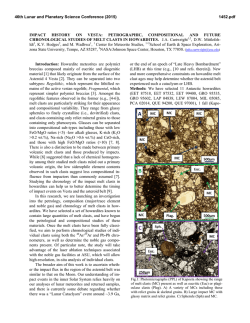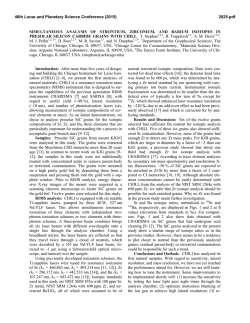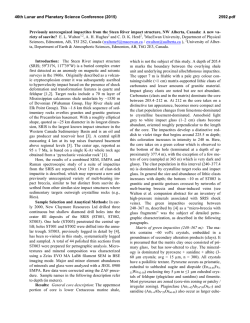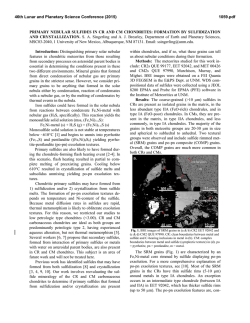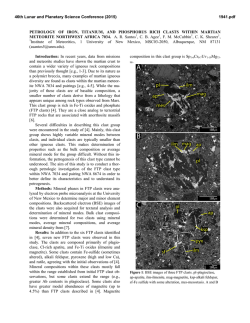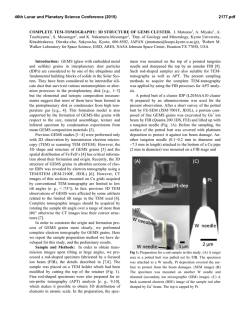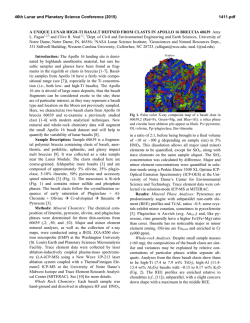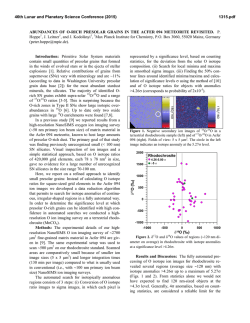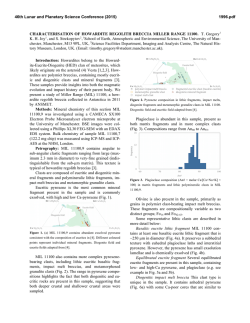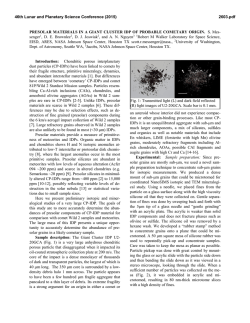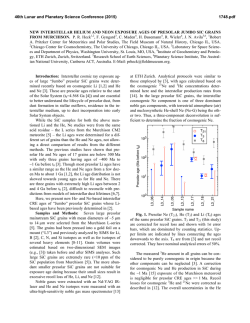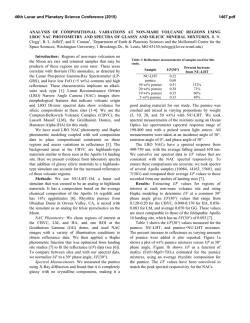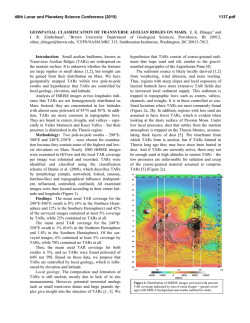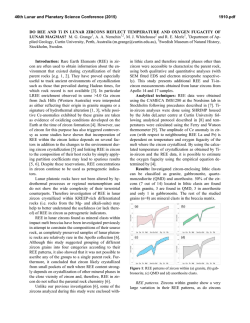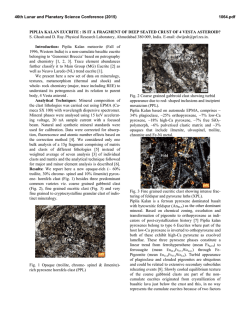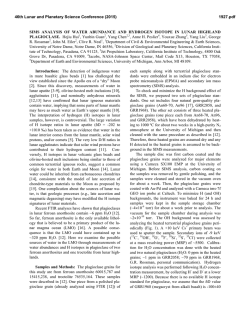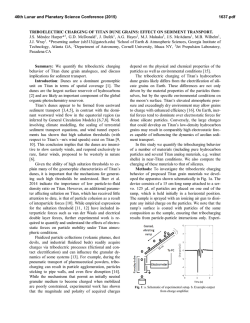
formation and stabilization of coarse grain
46th Lunar and Planetary Science Conference (2015) 1948.pdf FORMATION AND STABILIZATION OF COARSE GRAIN-MANTLED MEGARIPPLES ON EARTH AND MARS: INSIGHTS FROM THE ARGENTINEAN PUNA AND WIND TUNNEL EXPERIMENTS N.T Bridges1, M.G. Spagnuolo2, S.L. de Silva3, J.R. Zimbelman4, and E.M. Neely3; 1Johns Hopkins University Applied Physics Laboratory, Laurel, MD 20723 ([email protected]); 2IDEAN, UBA-CONICET Ciudad de Bs, As., Argentina; 3Oregon State Univ., Corvallis, OR 97331; 4CEPS/NASM, Smithsonian Institution, Washington, D.C. 20013-7012 Introduction The Martian surface contains a diversity of aeolian landforms, attesting to the effectiveness of wind as a major geomorphic agent despite the lower atmospheric pressure, gravity, and frequency of threshold winds compared to Earth. Martian “Transverse Aeolian Ridges” (TARs) have sizes and morphometric properties intermediate between dunes and ripples. They have been proposed as large megaripples formed via impact splash and creep, reversing dunes, or both [1-3]. TARs may be armored by coarse grains like those that characterize smaller plains ripples in Terra Meridiani [4], thereby accounting for their immobility as seen by HiRISE [5-6]. The gravel bedforms (megaripples) fields in Catamarca province, Argentina [7-9] are located in one of the windiest parts of the Argentinean Puna and may be the best terrestrial analog for at least some TARs [10] (Fig. 1). They are built on a bedrock of rhyolitic ignimbrites that contain about 10% by volume of lithic clasts with densities ranging from 2600 to 3000 kg m-3, and up to 20% crystal-poor pumice clasts with densities of ~800 to 1300 kg m-3. Currently, fine sand is being actively transported through the region. Previous investigations have been challenged by the absence of any local long term wind records and a poor understanding of the threshold speeds needed to set the various coarse-grained materials into motion and what effects the role of impacting pumice and sand has on these thresholds. These results, and implications for the formation of TARs, are reported here (preliminary work was reported in [11]; this abstract summarizes a paper currently in press [12]). Fig. 1: a) Megaripples and smaller inter-ripples in the Campo Purulla field. The arrow shows the direction of the strongest winds (pointing downwind) inferred from ripple geometry, which also corresponds to the maximum winds measured with the meteorology station. The position of the megaripples is influenced by bedrock topography whereas the smaller ripples are likely transporting clasts from one megaripple to the next. b) An example of uncovered sinuous bedrock ridges on the ignimbrite surface near the northeast margin of the Campo Piedro Pomez field (~28 km ENE from Campo Purulla). Such topography underlies the ripple fields, serving as gravel nucleation sites and thereby influencing the position of the primary ripple sets. Methods Wind Tunnel: The boundary layer wind tunnel at Arizona State University was used to study ripple formation, threshold stages, and freestream threshold speeds of Puna materials. Ripple components collected in the field were placed in the tunnel test section. For experiments simulating the impact of saltating particles, quartz sand and scoria, a proxy for impacting pumice, were used. An overhead still camera took pictures with a 1-minute cadence over the experiment duration. Side-mounted video and still pictures downwind and above the wind tunnel floor viewed the runs in perspective. Wind speed was gradually ramped up from zero and stages of particle motion (vibrating, sliding, rolling, and saltating) as a function of composition and approximate size noted. Field Meteorological Station: The station was placed in the Salar de Incahuasi field spaced more than 7 m from ~1 m high megaripples to the east and west, with N-S being approximate corridors between these bedforms. The local surface roughness is dominated by cm-scale pumice and lithic clasts, with some larger pumices of 10s of cm size. Wind ripple profiles show that the inter-megaripple troughs, including the location of the station, are not influenced by boundary layer separation as is the case nearer the megaripples [13]. Therefore, the profiles and roughnesses correlate to the troughs and the upwind portion of megaripples. Average wind speed and peak gust, and temperature, were recorded every 30 minutes from March 30 to November 17, 2013. Results Wind Tunnel: As the freestream wind speed in the tunnel increased, most particles transitioned through progressive stages of motion from their initial static state: 1) Vibrating: Grains oscillated back and forth from an anchored pivot point, generally along one axis of motion; 2) Sliding: Particles slid along the surface, usually in a constant direction; 3) Rolling: Grains rotated about an approximately fixed axis and migrated downwind; 4) Saltating: Particles hopped off the surface along a ballistic trajectory. The transitions show clear dependence on whether the particles were impelled by fluid forces only vs. being impacted by saltating quartz sand and scoria, with quartz sand- and especially scoria-impacted grains showing the greatest number of advanced stages, rolling and saltating. In addition to the lower threshold for scoria and quartz sand impact-impelled 46th Lunar and Planetary Science Conference (2015) conditions, the stage transitions from vibrating through saltating show a correlation to wind speed, with larger particles generally having greater thresholds. Field Meteorological Station: The data from the field meteorological station showed variable daily average and peak gusts over a range of 1-29 and 11-90 km hr-1, respectively. The highest speed winds were in the spring, although each month from April through November had days in which averages and gusts were at or exceeded 20 and 59 km hr-1, respectively. Rose diagrams of wind directions as a function of season and speed show that all winds and gusts exhibited a northwesterly to southwesterly flow, with winds > 5 km hr-1 up to gusts > 45 km hr-1 showing mostly northwesterly trends, consistent with the observed ripple orientation. When wind tunnel minimum vibration and 1 cm clast size saltation thresholds adjusted to Puna conditions are overlaid onto the field station data, it is seen that saltation, even for pumices, can only occur in gusts at certain times of the year and that once grains are protected within patches, saltation is even more rare (Fig. 2). Grains can vibrate through the year, but require gusts for detachment. The average daily winds do not modify the surface. Discussion The wind tunnel and weather station results support the sequence of Puna megaripple formation as previously proposed [10]: 1) Gusts are required to move the clasts when they are exposed to the oncoming wind, with saltating grains lowering threshold. Through all stages, pumices act as both saltating grains and impelling tools against other clasts. 2) Clasts self-organize into ripple-like features. 3) Once nucleated, interior ripple clasts remain fairly stable, with only the strongest gusts moving pumice and rarely, if ever, the lithics. 4) Gusts continually vibrate pumice and lithics, explaining why cores of the ripples are composed of sand and silt. In this scenario, wind-induced vibration of clasts allows sand and silt to settle among them, resulting in net upward clast movement and the formation of an accreted silt-sand core. It is likely that the vibrating grains cause not only sand and silt infiltration, but large grains to get jostled into stable positions. Therefore, the longer a clast sits on a ripple, the more stable it gets, such that redistribution decreases and stabilization increases with time. The applicability to the formation of TARs on Mars is best considered in terms of process and not as a direct material and size correlation. The Martian plains ripples of Terra Meridiani are armored with coarse granules overlying a fine-grained interior [4]. The two density fractions, basalt and the heavier hematite concretions (“blueberries”), are analogous to pumice and lithic clasts in the Puna, with the fine grained interiors of the ripples on both planets similar in terms of grain size. Examples of large TARs superposed on topographic flanks and smaller ones in swales have been documented on Mars, similar to the geometry in the Puna [10] (Fig. 1). In this model, 1948.pdf initially a random distribution of particles is sorted by the wind into those that can saltate versus denser and larger ones whose movement is mostly restricted to creep and traction along the surface, being impelled by the impact of saltating grains. Pre-existing topography offers natural nucleation sites. Then, once accumulated into ripple-like forms, the grains remain largely static, with rare Martian gusts occasionally vibrating the grains, allowing the settling of pervasive dust and some sand amongst the grains, inflating the bedforms over time. This is a likely formation mechanism for many transverse aeolian ridges on Mars. Fig. 2: The Puna wind data from the meteorology station with overlays of wind tunnel derived freestream thresholds adjusted for the atmospheric density at 4500 m. Wind speeds are shown in units of km hr-1 on the left axis and m s-1 on the right, with Mars equivalent speeds for the same aerodynamic force shown in parentheses in red. The thresholds are shown as gradational given the nature of the wind tunnel experiments and field conditions. The pumice and lithic thresholds are those for 1 cm particles. The black arrows show the most likely evolutionary path in the development of the Puna gravel-mantled megaripples, beginning with exposed clasts (“edge”) being impacted by saltating particles (generally pumices), to clumping of grains (“patch”) also exposed to saltating grains, to clumps sufficiently protected that they are sheltered from saltating particles. References [1] Bourke, M.C. et al. (2003), Lun. Planet. Sci, XXXIV, 2090. [2] Balme, M.R. et al. (2008), Geomorph., 101, 703-720. [3] Zimbelman, J.R. (2010), Geomorph., 121, 22-29. [4] Sullivan, R. et al. (2005), Nature, 436, doi:10.1038/nature03641. [5] Bridges, N.T. et al. (2012), Geology, 40, 31-34. [6] Bridges, N.T. et al. Aeolian Res., 9, doi:10.1016/j.aeolia.2013.02.004. [7] Milana, J.P. (2009), Geology, 37, 343-346. [8] de Silva, S. (2010), Geology, 38, e218. [9] Milana, J.P. et al. (2010), Geology, 38, e219-e220. [10] de Silva, S.L. et al. (2013), Geol. Soc. Amer. Bull., 125, 1912-1929. [11] Bridges, N.T. et al. (2014), Lun. Planet. Sci. XLV, 1855. [12] Bridges, N.T. et al. (2015), in press at Aeol. Res. [13] Zimbelman, J.R. et al. (2014), Lun. Planet. Sci. XLV, 1359.
© Copyright 2025
